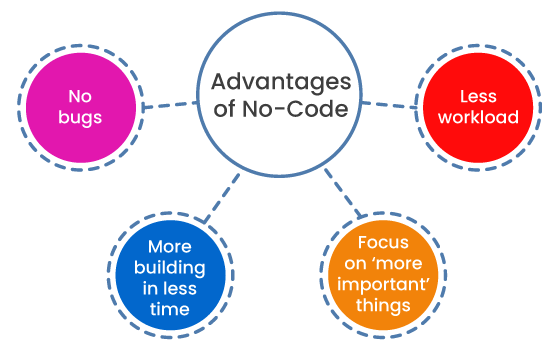
No-code platforms are revolutionary tools that let no code and traditional developer build various applications for different industries without the hassles of traditional coding. These platforms come with a robust collection of simplified visual drag-and-drop controls to use in code without actually writing a single line of code! Let’s learn what the synergy is and understand the difference of no code and traditional developers.
It is a well-known myth that no-code platforms are only good for building simple and operational-level applications. But in reality, today’s advanced no-code platforms can do much more than that. No-code empowers business users who have no technical backgrounds to build applications and turn their ideas into reality. The applications can be anything from simple workflow apps to enterprise-level applications.
So what about people who have a technical background? What about the traditional developers and coders? Is no-code-based programming going to leave coders jobless? Well, among all the myths surrounding no-code platforms, the biggest one is that these platforms are only ideal for business users. However, traditional developers and IT officials in companies can actually take advantage of these no-code platforms to make their lives easier rather than seeing them as their arch-nemesis and stay rigid against the change.
“No-code platforms are going to make traditional software developers obsolete” if this is one of your major concerns, we are here to make some arguments otherwise!
In the rapidly evolving landscape of software development, the lines between traditional coding and no-code solutions are blurring. Once seen as distinct approaches, these methods are now converging to create a powerful synergy that accelerates development, enhances efficiency, and opens up new possibilities.
Traditional development, relying on intricate coding and technical expertise, has been the cornerstone of software creation for decades. However, its time-consuming nature and steep learning curve have often hindered innovation and limited accessibility. No-code platforms, on the other hand, offer a visual interface that empowers individuals with minimal coding knowledge to build applications.
This article explores how no-code and traditional development can complement each other, creating a more efficient and effective workflow. By understanding the strengths and limitations of both approaches, developers can leverage the best of both worlds to deliver exceptional software solutions.
What do No-Code Platforms do for Traditional Developers?

1. No-code, No bugs
Well, almost!
According to Steve McConnell’s book, Code Complete (known as the developer’s encyclopedia), there are on average, about 15 to 50 defects per 1000 lines of delivered code, which is a lot! Fixing defects or Debugging is a time-consuming and mind-numbing task. The number of bugs can increase to almost hundreds and thousands in complex enterprise-level applications. And however draining it may be, coders still have to spend a massive amount of time debugging as bugs are a common security issue; thus cannot be ignored, which makes debugging a priority task.
However, with no-code solution development, the number of bugs decreases to a significant level. There is absolutely no code to be written. Simple visual tools do application building already tried and tested. These visual tools can be easily dragged and dropped to build apps just like you would build your favorite projects using Lego blocks.
There can still be some bugs, but these are related to how the business users build the applications using visual tools. The number is significantly low, making the application almost bug-free. The developers can instead spend the time using their technical bent of mind and use advanced features on no-code platforms to help business users build complex business applications which may be otherwise challenging for business users.
Also Read: No-Code and Gen Z: The Productive and Future-Proof Match

2. More building in less time
Developers and traditional coders spend a lot of time writing software programs. But they spend even more time testing and maintaining the code. With the advancement of time and technology, the demands of complex applications also increased. Enterprise-level applications are far more complex than they were 10 years ago. In such a demanding and competitive time, the traditional time-consuming coding for every big and small application needed in the organization can be a bad idea.

No-code platforms give software developers the ability to build more apps in less time, as there is no need to write code or test them. These platforms have pre-configured modules that can be used to build applications faster and more accurately. These modules have several advantages come with all core functionalities needed for different apps and can be deployed easily and faster. Thus no-code also makes it possible for the coders to work on multiple programs simultaneously. Pretty efficient, right?
Also Read: The Secrets of App Development: Building Excellence
3. More focus on ‘more important’ things
Software developers are constantly loaded with requests for creating solutions, applications, and other fixes. And, these solutions are not always directly proportional to creating value for the organization. For example, a solution request by HR for creating workflow applications for leave or payroll management. These requests get piled up, creating a lot of technical debt I.e., IT backlog for the developers. With all the actual work and the ever-piling technical debts, things can go haywire as it is humanly impossible to fix so many things so fast. According to Gartner, the demand for business apps is 5x higher than their delivery capacity.
It is but a myth that no-code, low code development will overtake the jobs of traditional software developers. In fact, no-code low-code development solutions will help businesses in removing these backlogs. As it will enable business users to create solutions for themselves on time, which IT cannot fulfill. No-code development is also helping software developers by improving their ability to tackle more complex business tasks. Because of no code, the time spent developing simple programming tools will now be switched to critical tasks. All the time that No code platforms spare the coders can be used for innovative thinking and developing systems and applications that showcase the coders’ skills better.
4. Less workload
When it comes to the IT departments of businesses, it can get very overwhelming. Most of the business users do not have any technical background, which is why all the programming work comes upon the IT team. Not just the programming but also fixing and patching those programs. Business teams do not actually get to participate in even building the systems that majorly work only for the business teams, thus creating a rift between the Business and IT teams.
Also Read: Why Choose Quixy as Your No-Code Application Development Platform?
However, through no-code platforms, IT and Business teams work more closely. The development of Apps and Systems became a collaborative project between the two departments, and IT officials’ workload decreased.
No-code platforms also empower business users to develop their own systems that will solely be used by the business teams and also have the capacity to fix any issues that may arise. And very interestingly, this is achieved without a lot of training and any formal background in coding. By empowering business users to make their own simple applications and fixing them when needed, IT teams are relieved of the extra pressure and workload while leaving more room for innovative thinking and new ideas.
Also read: No-Code Vs. Traditional Development (Coding)
Conclusion: Synergy Between No Code and Traditional Developer
Low-code and no-code tools can significantly speed up app development, often reducing project timelines by up to 90%. So there is not much profit for the traditional coders and developers to still see these platforms as an enemy and wage a war against them. Coding may get automated, but the skills will never die. So rather than keep swimming against the tide, coders can actually take some advantage of these platforms and have the luxury of time in these fast and demanding times to actually work on more innovative and creative things to achieve greatness.
Quixy is one such no-code platform that has delivered award-winning work toward developing applications without the unnecessary hassles of writing and testing codes. Quixy’s richly pre-configured visual tools not only help in building simple applications but also enterprise-level applications. Using Quixy’s revolutionary drag-and-drop modules, business users and professional coders have made really effective applications in the quickest possible time frames.
So if you are a professional developer who is looking forward to saving some time and rather invest it in more innovative long-term projects, Quixy’s no-code platform might be just the right thing for you!
Don’t miss out on the chance to elevate your processes. Take the first step and get started with Quixy today.
Frequently Asked Questions(FAQs)
What do no-code developers do?
No-code developers use RAD platforms to create software, automate processes, and build applications without traditional coding. They design and configure solutions using visual interfaces, making software development more accessible.
What are some benefits of no-code application development platforms?
Some benefits include faster development, reduced costs, accessibility to non-developers, rapid prototyping, and the ability to adapt to changing business needs with agility. Learn more.
What is the aim of no-coding platforms?
The aim is to democratize software development by enabling a broader range of individuals, including non-developers, to participate in creating digital solutions without the need for extensive coding.
What is the difference between low-code no-code development and traditional development?
Traditional development involves writing code from scratch. Low-code uses some coding but offers visual tools, while no-code doesn’t involve coding at all. The difference lies in the level of coding expertise required.
Will no-code replace developers?
No, no-code won’t replace developers. It complements their skills and empowers non-developers for certain tasks. Developers are still essential for complex, custom, and high-level projects.
Login
Please login to comment
0 Comments
Oldest















